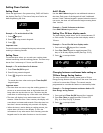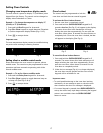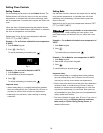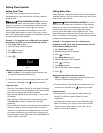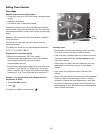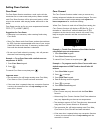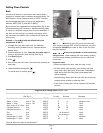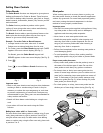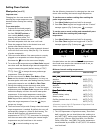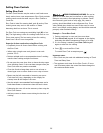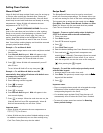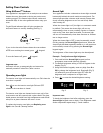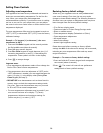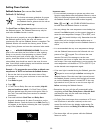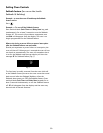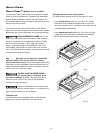
24
Meat probe (cont’d)
To set meat probe:
1. Prepare the food and properly
insert the temperature probe into
the food.
DO NOT preheat or
start cooking before properly
inserting the meat probe. The
probe should be inserted into the
food and receptacle while the oven is still cool.
2. Place the prepared food on the desired oven rack
position and slide into the oven.
3. Plug the meat probe into the probe receptacle located
on the left front oven cavity side (See Fig. 1 for location
of probe receptacle).
4. The oven control detects if the meat probe is correctly
plugged in to receptacle and when recognized will
illuminate the icon in the oven control display.
5. To set the target temperature press Meat Probe keypad
once then enter the desired target internal temperature
using the numeric key pads (default setting is 170ºF/
77ºC)†. Press
to accept the meat probe target
temperature. Close the oven door.
6. Set the oven control for Bake, Conv Bake or Conv
Roast and the desired oven temperature. You may use
the meat probe with some other baking features, but the
meat probe cannot be set with Broil or Flex-Clean.
7. During the cooking process the actual meat probe
temperature will display by default. To view the target
temperature press the Meat Probe keypad once. After 6
seconds the display will show the actual meat probe
temperature. If the target temperature needs to be
changed during the cooking process, press the Meat
Probe keypad once and use the numeric keypads to
adjust the target temperature. Press the
key to
accept any change.
8. The oven control will provide 3 beeps when the internal
target temperature is reached. By default the oven will
automatically change to a Warm & Hold setting. The
Warm & Hold function will maintain the oven
temperature at 170° F (77°C). Instructions for changing
how the oven reacts after reaching the internal target
temperature may be found later in this section.
Press
to cancel cooking at any time.
See the following Instructions for changing how the oven
reacts after reaching the internal target temperature.
To set the oven to continue cooking after reaching the
probe target temperature:
1. Press Meat Probe keypad and hold for 6 seconds.
2. Press Flex Clean keypad and toggle until the “Continu”
message appears (Fig. 2) then press
to accept.
† The U.S. Department of Agriculture states, “Rare fresh
beef is popular, but you should know that cooking it to
only 140°F/60°C means some food poisoning organisms
may survive.” (Source: Safe Food Book, Your Kitchen
Guide, USDA Rev. June 1985.) The lowest temperature
recommended by the USDA is 145°F/63°C for medium
rare fresh beef.
To set the oven to cancel cooking and automatically start
Warm & Hold after reaching the probe target
temperature:
Fig. 2
Fig. 3
1. Press Meat Probe keypad and hold for 6 seconds.
2. Press Flex Clean keypad and toggle until “CAnCEL”
message appears (Fig. 3) then press
to accept.
Important note:
Changing how the oven reacts after
reaching the target temperature must
be done before starting the cooking
process.
Setting Oven Controls
Minimum internal cooking temperatures:
Food type Internal Temp.
Beef, veal, lamb-roasts, steak & chopsBeef, veal, lamb-roasts, steak & chops
Beef, veal, lamb-roasts, steak & chopsBeef, veal, lamb-roasts, steak & chops
Beef, veal, lamb-roasts, steak & chops
Medium 160°F (71°C)
Well done 170°F (77°C)
Fresh pork-roasts, steaks & chopsFresh pork-roasts, steaks & chops
Fresh pork-roasts, steaks & chopsFresh pork-roasts, steaks & chops
Fresh pork-roasts, steaks & chops
Medium 160°F (71°C)
Well done 170°F (77°C)
Ham-Cook before eatingHam-Cook before eating
Ham-Cook before eatingHam-Cook before eating
Ham-Cook before eating 160°F (71°C)
PoultryPoultry
PoultryPoultry
Poultry
Whole chicken, turkey 165°F (74°C)
Breasts, roasts 165°F (74°C)
Stuffing (cooked alone or in bird) 165°F (74°C)
Leftovers 165°F (74°C)
Information courtesy the U.S. Department of Agriculture Food
Safety and Inspection Service.
Provided below are the minimum
internalinternal
internalinternal
internal temperatures
that foods must reach to be considered safe to eat, no
matter how you prepare them.
Fig. 1



